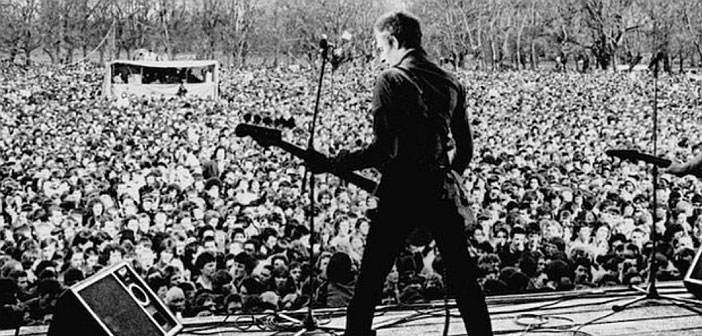Source: The Telegraph
The sight of black, white and Asian kids enjoying music together undermined the far-right credo that the races were intrinsically hostile to each other.
Forty years ago, on April 30 1978, tens of thousands of people took part in a huge march through London, from Trafalgar Square to Tower Hamlets to protest against rising levels of racism. There, among the trees at Victoria Park, bands such as the Clash, Birmingham reggae stars Steel Pulse and X-Ray Spex, whose singer was a mixed-race girl from Bromley with the inimitable name of Poly Styrene, performed to a crowd that by early evening had swelled to as many as 100,000.Many had travelled from all over the country: 42 coaches came from Glasgow alone. I, too, was there, a teenage punk rocker who came down by coach from Oxford and was painfully conscious of the suspicious stares from some of the white East Enders watching as we made our way to Victoria Park.
But in the park we were greeted by hundreds of black and white teenagers, fellow punks, rastas, skinheads, soul boys and ageing hippies: people from all sorts of backgrounds who had come together to fight racial prejudice.
Looking back it’s no exaggeration to say that concert, organised by a grass roots organisation called Rock Against Racism, not only paved the way for blockbuster benefit gigs such as Free Nelson Mandela and Live Aid, but helped fundamentally change attitudes to race in Britain.
Initially unsure whether the Victoria Park carnival would find an appreciative audience, the organisers anticipated at best that 20,000 people would turn up. Instead, in the words of the late veteran anti-fascist campaigner Gerry Gable, the event would prove to be “one of the most important cultural events of the postwar period”.
The black campaigner Darcus Howe, who died last year, said that he had fathered five children in Britain and that while the first four had grown up angry, thanks to Rock Against Racism his fifth had grown up “black and at ease”.
Today we are used to musicians aligning themselves with good causes. But back in the mid 1970s Rock Against Racism was one of the first movements that asked pop stars to take a stand on race. And at that point picking sides well and truly mattered. Racial tension on the street was dangerously high.
In 1977 the far-right National Front knocked the Liberals into fourth place in the Greater London Council elections, winning 119,000 votes. In east London, Asians were being subjected to vicious attacks – 110 alone between January 1976 and August 1978 – culminating in the murder of Kenneth Singh in Plaistow in April 1978.
Ironically the flame that sparked the birth of RAR was kindled by bigotry within rock music itself. In August 1976, Eric Clapton drunkenly championed Enoch Powell’s Rivers of Blood speech while performing in Birmingham. He declared that Britain was becoming a “black colony” and that he wanted “foreigners out”. It was the spur that the photographer Red Saunders and his friend, the designer Roger Huddle, who had been thinking about setting up an organisation to combat racism, needed.
They penned a furious response to Clapton in the form of an open letter in the New Musical Express. “Half your music is black,” they wrote. “You’re a good musician, but where would you be without the blues and R’n’B?” They encouraged readers to get behind the then fledgling RAR. “We want to organise a rank-and-file movement against the racist poison in music. We urge support for Rock Against Racism.”
“It was an emergency,” Saunders says now. “People were being attacked and murdered.” From the beginning his chosen mode of protest was to champion rock’s black roots. “We were music fans looking for a way for ordinary kids who loved black music to have a voice. Out of that came a youth campaign that wasn’t about boring old-fashioned politics, but harnessed the energy of new sounds like punk and reggae.”
Rock Against Racism marked the point when politics and music came together to fight a common enemy. In May 1977, Peter Hain, the future Northern Ireland Secretary; Ernie Roberts, later a Labour MP, and Paul Holborow, a Socialist Workers Party activist, set up the Anti-Nazi League in an attempt to undermine the credibility of the National Front and expose it as racist.
Their objectives chimed with the preoccupations of the then nascent punk movement, as bands like the Clash and the Sex Pistols started aligned themselves with reggae, undermining fascist attempts to woo white youths.
“Racism was totally in-your-face then,” says Don Letts, the DJ who introduced punks to black music by spinning dub and reggae records at The Roxy club in Covent Garden in the 1970s. “If I wasn’t being chased by the National Front I was being stopped by the police using the ‘sus’ laws. But the Clash and the Sex Pistols grew up with black people living next door, and I bonded with them as friends through our love of black music. We came together through an understanding of our differences. Punk and RAR were immeasurably important at street level because they created a mutual respect.”
In August 1977, the ANL took the controversial decision to confront the National Front on the streets, mounting a huge demonstration that broke up an NF march through Lewisham, in south east London. Meanwhile, RAR started organising gigs and discos, starting at the Royal College of Art and culminating in the Victoria Park Carnival.
The sight of black, white and Asian kids enjoying music together did much to undermine the credo of the far-right that the races were intrinsically hostile to each other and could not mix on an equal footing. Nor was it just about racism: at Victoria Park, Tom Robinson had urged the crowd to join in with the chorus of his groundbreaking song Glad to be Gay, this at a time when the few visible gay figures were effeminate stereotypes lampooned in TV sit coms.
Two more RAR concerts followed in south London’s Brockwell Park and Leeds, and later a string of concerts up and down the country that brought together white, black and multiracial punk, funk, soul and reggae bands on the same stage, in many places for the first time.
In the years that followed, this emerging multiculturalism was reflected on TV, as Two Tone bands such as The Specials, Selector and The Beat gained commercial success.
In 1988, musicians from all backgrounds came together at Wembley to stage the huge Free Nelson Mandela concert, in protest against the long imprisonment of the anti apartheid leader. “Jerry Dammers, who organised the Wembley concert, was inspired by Victoria Park,” says Billy Bragg, who as a 19-year-old boy travelled from Barking to Victoria Park. “The whole Two Tone movement was a vindication of RAR.”
Today the British music scene is visibly diverse: note the celebration of Stormzy, Jorja Smith and Kendrick Lamar at this year’s Brit Awards. There is still a way to go but Britain has become a profoundly more multicultural country since the bad old days of the Seventies. And in some crucial way that’s down to RAR. “I think it was decisive in running the NF out of town,” says Hain now. “It helped create a climate in which being racist was not acceptable.”
Or as Tom Robinson, now a BBC6 broadcaster who will later this year perform his Power in the Darkness album at a number of gigs on the occasion of its 40th anniversary, put it: “It was our Woodstock.”
SEE ALSO: Rock Against Racism: Syd Shelton images that define an era
09 December 2018 Unite Against Fascism and Racism | Details…
 09 December | No Pasaran
09 December | No Pasaran
United Against Fascism and Racism
Stop Tommy Robinson
Assemble 11am BBC Portland Place
March to Whitehall.

